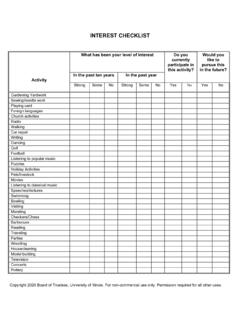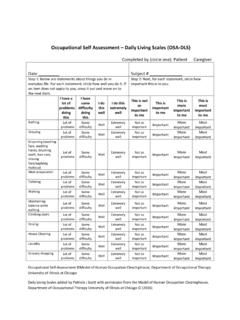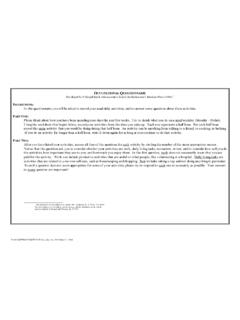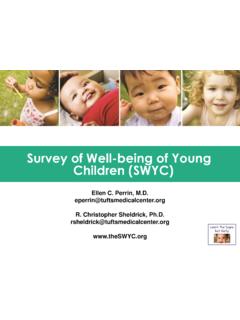Transcription of The Role Checklist - moho.uic.edu
1 The Role Checklist Background Within the occupational behavior tradition, roles are characterized as critical determinants of productivity. Occupational roles organize behavior by contributing to one's personal identity, conveying social expectations for performance, organizing use of time, and including the individual within the social structure. The occupational therapist s unique view of disability involves understanding how illness or injury affects occupational role performance. Successful adaptation after illness or injury may depend on a person's ability to competently resume or to establish new occupational roles. The Role Checklist was designed to elicit information about a person's occupational roles. Occupational roles consist of both playful and productive behaviors. Playful behaviors are characterized as non work such as hobbies, sports, or social recreation. Productive behaviors contribute some service or commodity that others need or desire.
2 The Role Checklist has been translated into ten languages (Arabic, Dutch, French, German, Japanese, Portuguese, Spanish, Swedish, Chinese, & Hebrew) for international use. It is a reliable and valid assessment tool that provides: 1. Data on individuals perception of their participation in roles throughout their lifespan. 2. Data regarding the degree to which each role is valued. 3. Supplemental information regarding an individual s capacity to maintain a balance among roles. Description of the Role Checklist The Role Checklist is a written inventory, requiring approximately fifteen (15) minutes to administer, and is appropriate for use with an adolescent, adult, or elderly population. It is divided into two parts. Part 1 assesses, along a temporal continuum, the major occupational roles that organize an individual's daily life. Part 2 identifies the degree to which each occupational role is valued.
3 The occupational roles included in the Role Checklist are: student, worker, volunteer, care giver, home maintainer, friend, family member, religious participant, hobbyist/amateur, and participant in organizations. There is also an "other" category where individuals can enter additional roles not listed. It should be noted that the role definitions include examples that are not meant to be all encompassing. The intent of the Checklist is to identify roles with occupational components that serve to organize an individual's daily life. Thus, reference to frequency of performance is included in role definitions. For example, the role of family member refers to spending time or doing something, at least once a week, with a family member such as a spouse, child, parent, or other relative. The key phrase is once a week. People may view themselves as family members, but their family may reside out of town resulting in infrequent contact.
4 Consequently, that role is not available to organize present daily life. Administration of the Role Checklist Instruct individuals to complete the demographic information at the top of the Checklist . Remain with them until the Checklist is completed. Part 1 1) Ask them to read the instructions. 2) Inquire if they understand the instructions and answer any questions pertaining to the administration of Part 1. 3) Define the time frames as follows: a) Present refers not only to today, but also includes the previous seven days. b) Past refers to the period of time up until seven days ago. c) Future is anytime from tomorrow onward. Part 2 1) When individuals have completed Part 1, ask them to read the instructions for Part 2 2) Inquire if they understand the instructions and answer any questions pertaining to the administration of Part 2.
5 3) Define "valuable" as follows: "Valuable refers to the worth you place on each role, that is, how important or desirable the role is to you." Recommended Reading The following book by Dr. Gary Kielhofner discusses the theoretical framework upon which the Role Checklist was developed and presents numerous cases in which the Checklist was used clinically. Kielhofner G. (Ed.) A Model of Human Occupation: Theory and Application, (3rd Edition), Baltimore: Lippincott, Williams and Wilkins, 2002. Publications using the Role Checklist Colon, H & Haertlein, C. Spanish translation of the role Checklist . American Journal of Occupational Therapy, 56, 586-589, 2002 Gillard M & Segal M. Social roles and subjective well -being in a population of nondisabled older adults. Occupational Therapy Journal of Research, 22 96S-96S, 2002. Hachey, R, Boyer, G & Mercier, C. Perceived and valued roes of adults with severe mental heath problems.
6 Canadian Journal of Occupational Therapy, 68, 112-120, 2001. Prusti, S & Branholm, IB. Occupational roles and life satisfaction in psychiatric outpatients and vocational disabilities. Work, 14, 145-149, 2000. Dickerson A. The Role Checklist . In B Hemphill-Pearson (Ed.) Assessments in Occupational Therapy Mental Health: An Integrated Approach. New Jersey: Slack, 175-191, 1999. Ponsford J, Olver J, Nelms R, Curran C & Ponsford M. Outcome measurement in an inpatient and outpatient traumatic brain injury rehabilitation programme. Neuropsychological Rehabilitation, 9, 517-534, 1999. Kinebanian, A, Thomas, C, Verhoef, JAC, & Verschuur. Model of Human Occupation 4- Rollenijst (Role Checklist ): Rollen en gewoonteijst (role and habits), Hogeschool von Amsterdam, Inst. Ergotherapie, 1998. Levitt VB. Anxirety disorders. In A. MacRae & E Cara (Eds.) Anxiety Disorders in Psychosocial Occupational Therapy A Clinical Practice.
7 New York:Delmar Publishers, 359-403, 1998. Crowe TK, VanLeit B, Berghmans KK & Mann P. Role perceptions of mothers with young children: The impact of a child s disability. American Journal of Occupational Therapy, 51, 651-661, 1997. Frosch S, Gruber A, Jones C, Myers S, Noel E, Westerlund A & Zavisin T. The long term effects of traumatic brain injury on the roles of caregivers. Brain Injury, 11, 891-906, 1997. Tompson H & Werner J. The impact of role conflict/facilitation on core and discretionary behaviors: Testing a Mediated model. Journal of Management, 23, 583-601, 1997 Asher I. Occupational Therapy Assessment Tools: An Annotated Index, (2nd Edition), Bethesda, MD, American Occupational Therapy Association, 1996. Kusznir A, Scott E, Cooke RG & Young LT. Functional consequences of Bipolar Affective Disorder: An occupational therapy perspective. Canadian Journal of Occupational Therapy, 63, 313-322, 1996.
8 Dickerson A & Oakley F. Comparing the roles of community-living persons and patient populations. American Journal of Occupational Therapy, 49, 221-228, 1995. Hachey R, Jumoorty J & Mercier C. Methodology for validating the translation of test measurements applied to occupational therapy. Occupational Therapy International, 2, 190-203, 1995. Kielhofner G. (Ed.) A Model of Human Occupation: Theory and Application, (2nd Edition), Baltimore: Williams and Wilkins, l995. Branholm IB & Fugl-Meyer AR. On non-work activity preferences: relationships with occupational roles. Disability and Rehabilitation, 16, 205-216, 1994. Hallett JD, Zasler ND, Maurer P & Cash, S. Role change after traumatic brain injury in adults. American Journal of Occupational Therapy, 48, 241-246, 1994. Rosenfeld M. Wellness and lifestyle renewal: A manual for personal change. Rockville, MD: American Occupational Therapy Association, 1993.
9 Branholm IB & Fugl-Myer AR. Occupational role preferences and life satisfaction. Occupational Therapy Journal of Research, 12, 159-171, 1992. Egan M, Warren SA, Hessel PA & Gilewich G. Activities of daily living after hip fracture: pre- and post discharge. Occupational Therapy Journal of Research, 12, 342-356, 1992. Stoffel VC. The Americans with disabilities act of 1990 as applied to an adult with alcohol dependence. American Journal of Occupational Therapy, 46, 640-644, 1992. Baker F, Curbow B & Wingard, JR. Role retention and quality of life of bone marrow transplant survivors. Social Science and Medicine, 32, 697-704, 1991. Bavaro SM. Occupational therapy and obsessive-compulsive disorder. American Journal of Occupational Therapy, 45, 456-458, 1991. Vause-Earland T. Perceptions of the role assessment tools in the physical disability setting. American Journal of Occupational Therapy, 45, 26-31, 1991.
10 Watson MA & Ager CL. The impact of role valuation and performance on life satisfaction in old age. Physical and Occupational Therapy in Geriatrics, 10, 27-62, 1991. Sepiol JM & Froehlich J. Use of the role Checklist with the patient with multiple personality disorder. American Journal of Occupational Therapy, 44, 1008-1012, 1990. Asher I. An Annotated index of OT Assessment Tools. Rockville, MD: American Occupational Therapy Association, 1989. Ebb EW, Coster W & Duncombe L. Comparison of normal and psychosocially dysfunctional male adolescents. Occupational Therapy in Mental Health, 9, 53-74, 1989. Pizzi M. The model of human occupation and adults with HIV infection and AIDS. American Journal of Occupational Therapy, 44, 257-264, l989. Barris R & Dickie V. Response to commentary on A Comparison of Psychiatric Patients and Normal Subjects Based on the Model of Human Occupation.












